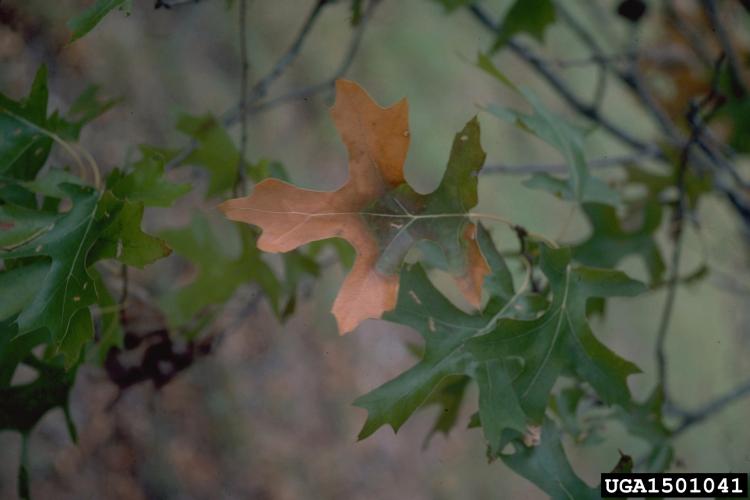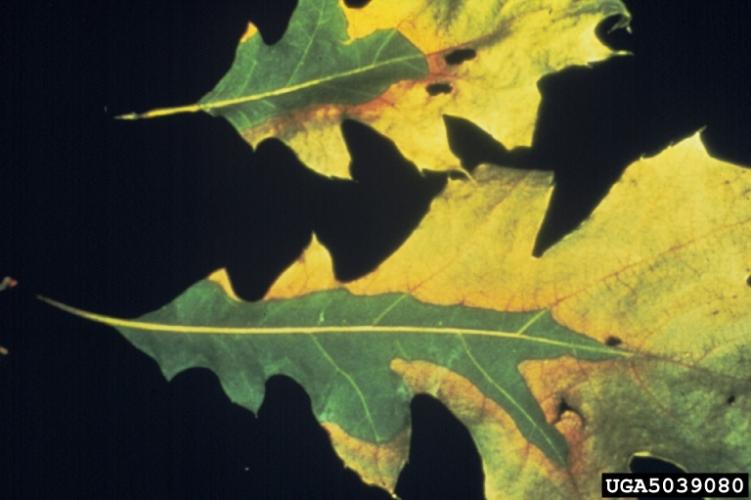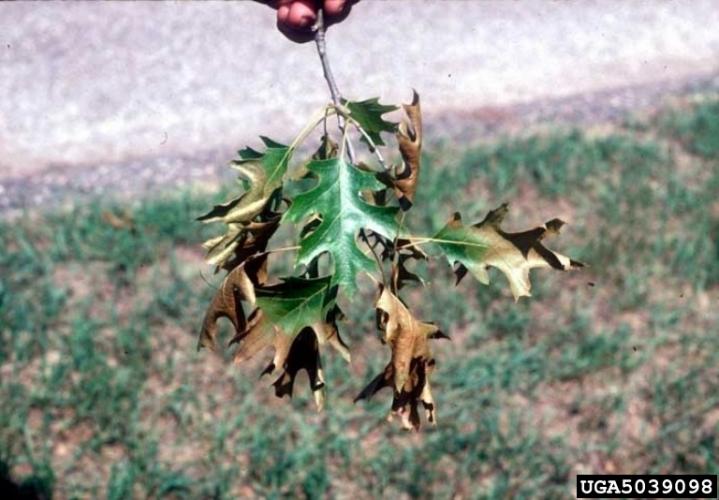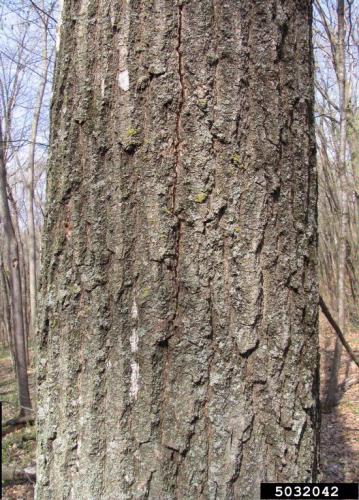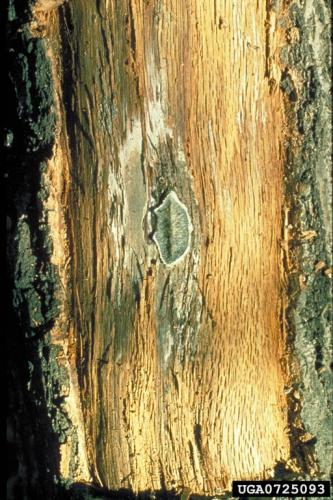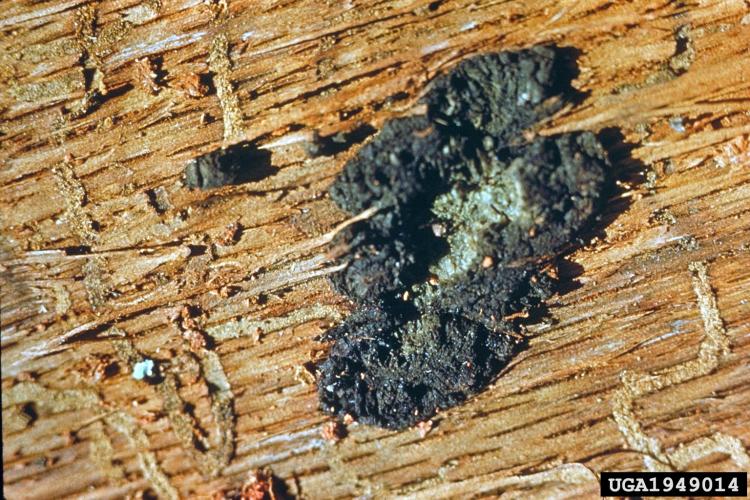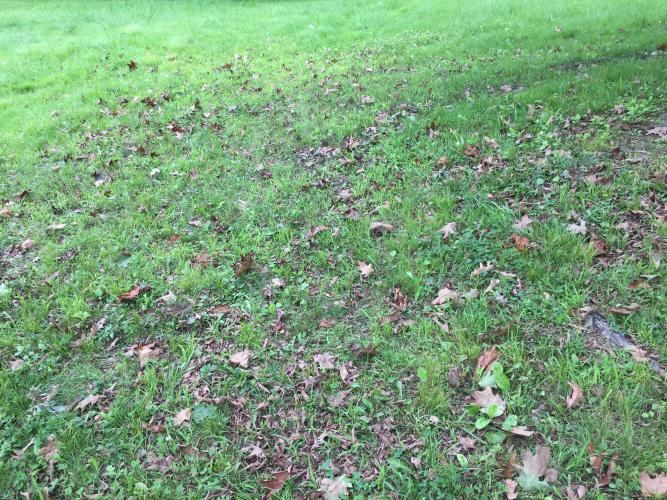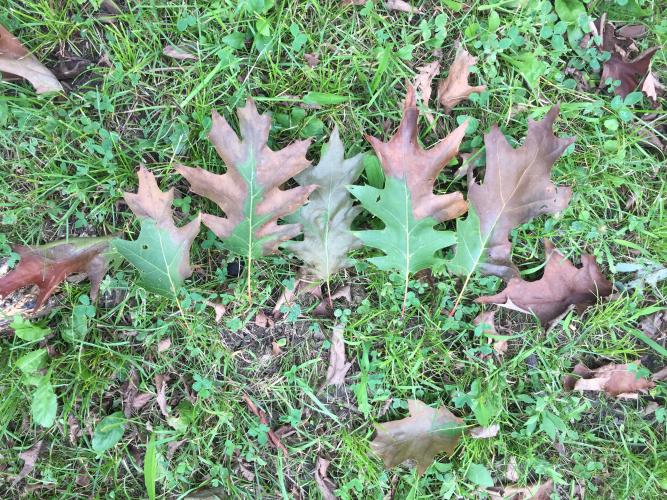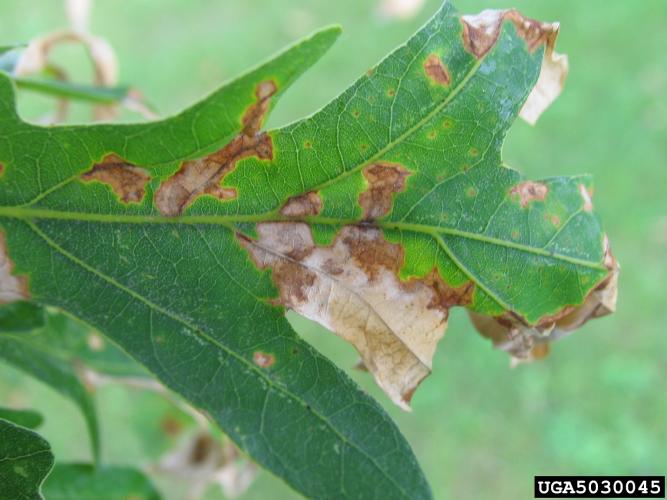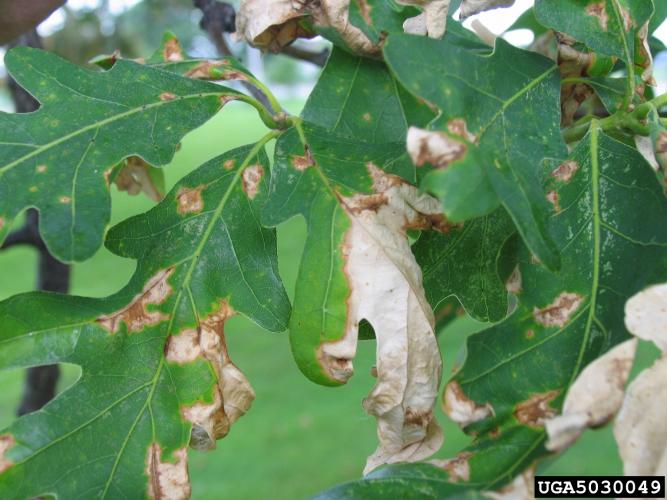Oak Wilt
Identification
Oak wilt is caused by the fungus Bretziella fagacearum (formerly Ceratocystis fagacearum). While this disease has not been observed in Vermont, oak wilt has become a major pest in parts of central and eastern United States.
The fungus grows into and throughout the water conductive tissues (sapwood) of the host tree. This causes a defensive reaction in the tree, which results in further plugging of the tree’s vessels. The tree’s ability to uptake water is compromised, causing a wilting syndrome, and often leading to mortality.
No species of oak is known to be immune to this vascular disease. Over 35 species of native and exotic oak are susceptible.
signs and symptoms
Red oak group
- Wilting occurs in upper canopy and on outermost branches first, then progresses down the tree and into inner canopy.
- Wilting leaves are often discolored along outer edges, with discoloration ranging from pale green to yellow, bronze, or brown.
- Wilting results in heavy leaf drop of both green and discolored leaves during the summer growing season
- Trees may die in as little as 1 or 2 months of infection and most die within a single year.
- Fungal mats may form beneath the bark of trees recently killed by oak wilt. Pressure pads associated with these fungal mats can sometimes cause vertical bark splits.
White oak group
- It may take several years for trees in the white oak group to be killed by oak wilt, sometimes losing only a few branches each year.
- Removing the bark may reveal streaking in the sapwood of smaller branches and twigs on actively wilting trees.
- Fungal mats are uncommon on trees in the white oak group.
See image slideshow above for signs and symptoms.
Biology
origin
Oak wilt was first identified in 1944, in Wisconsin but due to difficulty isolating and identifying the fungus, the extent of the disease and its impact were not understood until the 1980s. The origins of the disease remain unknown. Some scientists think it is an exotic disease to the United States, although it has not been reported anywhere else in the world. Others argue that the fungus is native to the eastern United States and that it has become more prevalent in recent years due to an increase in modes of infection (tree wounding due primarily to home construction in oak woods).
Life Cycle
The oak wilt fungus spreads underground through the tree's roots, overland by insect vectors, and by humans moving infected material.
Local Spread
Most new tree infections occur when the fungus moves from an infected tree to a nearby healthy tree through connected root systems. The roots of trees in each oak group (red or white) commonly graft to roots of other trees in the same group, forming a continuous underground network. When one tree in a group becomes infected and dies, the fungus spreads through the connected root systems, killing more trees and creating an infection center. Root grafts do not commonly occur between trees of different oak species groups, although exceptions occur.
Overland Spread
New infection centers can occur if the fungus is carried from an infected tree to a fresh wound on a healthy tree by an insect. Under certain moisture and temperature conditions, compact masses of fungal material that produce spores, called spore mats, sometimes form on oak trees that have been killed by oak wilt. These mats form just under the bark and are in contact with both the bark and the infected sapwood of the tree. As the mats mature, they produce specialized, non-spore-producing structures that exert outward pressure on the bark and cause it to split, thus providing a route for insects to reach the mats.
Oak wilt spore mats emit a strong, fruity or wine-like odor that attracts many different species of nitidulid beetles, also known as sap beetles. As they feed on or tunnel through the spore mats, nitidulid beetles often accumulate fungal spores on the surface of their bodies.
Oak trees often sustain wounds caused by construction equipment, storms, pruning tools, or vandalism. Fresh wounds usually leak sap that attracts insects, including nitidulid beetles that have visited oak wilt spore mats, thus spreading the disease.
Oak bark beetles can also carry spores of the oak wilt pathogen and help create new infection centers. These beetles acquire spores of the fungus just prior to emerging from oak wilt-killed trees and subsequently transmit them when feeding in the crowns of healthy oaks. (Text excerpted from USDA Northeastern Area Forest Service publication How to Identify, Prevent and Control Oak Wilt.)
Ecological Threat
Oak wilt is a lethal disease that threatens Vermont's oak trees. It has the strongest effect on members of the red oak family (red oak, pin, black oak) Members of the white oak family are not nearly as susceptible (white oak, swamp white oak, burr oak, etc). The disease has the potential to be as serious as Dutch Elm Disease. Both are introduced, exotic diseases caused by vascular wilt fungi; both diseases are transmitted by insects; both diseases can be transmitted through root grafts, and both fungi kill their host plants quickly.
Vermont Distribution
Oak wilt has not been detected in Vermont
Citations
Photo Credit
John N. Gibbs, Forestry Commission, Bugwood.org
Joseph OBrien, USDA Forest Service, Bugwood.org
C.E. Seliskar, Bugwood.org
Paul A. Mistretta, USDA Forest Service, Bugwood.org
5030045 & 5030049, Joseph OBrien, USDA Forest Service, Bugwood.org
information credit
How to Identify, Prevent, and Control Oak Wilt- by US Forest Service
